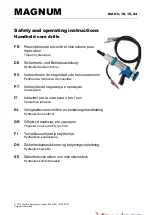
2
CONTENTS
Thank you for choosing Weber! We hope you
enjoy many years of faithful service from
your grill. We’re pleased to present you with
this cookbook full of Weber’s tried-and-true
grilling recipes. Each recipe in this book
includes the grilling method and heat setting
to use on your Weber
®
gas grill. The charts in
this book will be a helpful, easy reference.
If these recipes whet your appetite for more,
visit our web site at www.weber.com
®
. We’re
always serving up something new. Or call
us on our toll-free number, 1-800-446-1071.
Our customer service center is open around-
the-clock to answer all your questions. Best
wishes and happy grilling!
WEBER GRILLING BASICS:
WHAT YOU NEED TO KNOW
All good cooks have a few secrets they like
to keep to themselves. Not us—we like to
share them! We think the keys to our success
should be yours as well. Here’s the inside
scoop to help you get the best results:
To start your gas grill:
Open the lid. Check
that all burner control knobs are turned to
OFF and that your fuel tank is not empty.
Turn the gas supply on at the source.
Light the grill according to the directions in
the owner’s manual. Close the lid and preheat
the grill until the thermometer reaches
500°F to 550°F. This will take about 10
minutes. To grill, adjust burner controls as the
recipe directs.
Grilling temperatures:
At the top of each
recipe, we indicate the requisite cooking
method (direct or indirect) and temperature
level (high, medium, or low). Note that a grill
set up for indirect cooking can accommodate
both methods (just move the food directly
over the fire for direct cooking). Where
searing is particularly important to the texture
or flavor, we note that as well (e.g., Sear:
High, Cook: Indirect Medium).
Keep the lid down!
Without a doubt, the most
important grilling rule. Lifting the lid allows
heat to escape, increasing your grilling time.
A closed lid also reduces the chance of flare-
ups (and closing the lid extinguishes them
quickly). Open the grill only to turn foods as
indicated in the recipes. More poking and
flipping won’t make it taste better, trust us.
GRILLING & FOOD SAFETY
»
Trim excess fat from steaks, chops and
roasts, leaving no more than a scant 1⁄4
inch of fat. Less fat is a virtual guarantee
against unwanted flare-ups.
»
If an unwanted flare-up should occur,
turn all burners to OFF and move food to
another area of the cooking grate. Any
flames will quickly subside. After flames
subside, relight the grill. NEVER USE
WATER TO EXTINGUISH FLAMES ON A
GAS GRILL.
»
Do not line the funnel-shaped bottom tray
with foil. This could prevent the grease
from flowing into the grease catch pan.
»
Make sure the bottom tray and grease
catch pan are always clean and free from
debris.
»
Grills radiate a lot of heat, so always
keep the grill at least 2 feet from any
combustible materials, including the house,
garage, deck rails, etc. Never use a grill
indoors or under a covered patio.
»
When you’re finished grilling, turn off the
burners and the LP tank or source.
»
Wash hands thoroughly with hot, soapy
water before starting any meal preparation
and after handling fresh meat, fish, and
poultry.
»
Defrost meat, fish, and poultry only in the
refrigerator, never at room temperature.
»
Never spray or brush oil on a hot cooking
grate. Oil the food instead.
»
Never place cooked food on the same
platter that the raw food was placed on.
»
Vigorously boil marinades that were
used for raw meats, fish, or poultry for 10
seconds before using as a baste or sauce.
Содержание Summit 56211
Страница 109: ...www weber com 109 MEMO...
















































